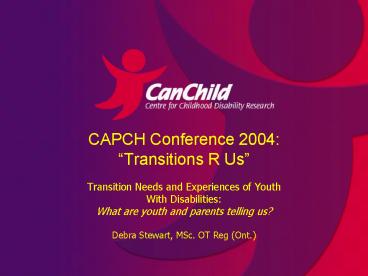Transition Needs and Experiences of Youth - PowerPoint PPT Presentation
1 / 13
Title:
Transition Needs and Experiences of Youth
Description:
A qualitative study of the transition to adulthood for youth ... like a snow plow, you know, they shovel the snow for you but you really have to make the ride. ... – PowerPoint PPT presentation
Number of Views:19
Avg rating:3.0/5.0
Title: Transition Needs and Experiences of Youth
1
CAPCH Conference 2004 Transitions R Us
- Transition Needs and Experiences of Youth
- With Disabilities
- What are youth and parents telling us?
- Debra Stewart, MSc. OT Reg (Ont.)
2
A qualitative study of the transition to
adulthood for youth with physical disabilities
(1998)
- Purpose of study
- To explore and describe the nature of the
transition experience from different peoples
perspectives, in order to gain a better
understanding of their needs for services. - Qualitative Methods
- Individual, semi-structured interviews
- Purposeful sampling
- 34 participants from 3 regions of south-central
Ontario 21 youth (ages 19 30 years),
12 parents, 1 service provider
3
Themes about Transition to Adulthoodfor youth
with physical disabilities
- Three Main Categories
- (i) Context
- (ii) Transition Process
- (iii) Needs and Services
4
The Context
- The Current Situation
- Theyre surviving and their quality of life is
becoming better and better all the time I think
coming right now into this generation, you can
have more people with disabilities into
society, working - The Existence of Two Worlds
- Like youve got the able-bodied person saying
they cant do thistheir attitude is they are
afraid because they dont know how to change. And
the disabled persons sic attitude is that
they cant do it because its not available for
them. They dont know how to change it. - Result Poor Person-environment Fit
5
The Transition Process
- Changes in person and environment
- for young adults with disabilities
- for parents
- I was used to having those 8 hours when they
wouldnt be homeand I was scared. I thought how
is this going to work out? I know there is hardly
anything out there I was scared of burning
out.. - Barriers and Supports
- " Its attitude - thats what matters. Id rather
have five steps and a wonderful attitude, not the
ramp and have people turn away.
6
Different experiences for youth with physical
disabilities and their parents
- For Youth
- other kids at age six are learning to read and
write and skip and perhaps be in dancing classes
and that, theyre still learning to walk and do
their catheter, you know so theyre going to be
delayed in getting community kinds of skills. - For Parents
- its hard to look into the future. I think
its something I just havent really done that
much because it would be a disappointment. - The Cliff
- like dropping them off a cliff, where, you know
its like you cut the parachute strings and say
okay, take care of yourself now.
7
Needs and Services
- Building a bridge to the adult world
- (i) Self
- the biggest change is to become your own
decision-maker, to direct your own care and to
learn all those little discreet decisions, about
what it is that you do. - (ii) Environment
- because only until they are able to see a
disabled person sic in action, working, will
they be able to really see that theyre not
stupid after all. - (iii) Support
- because we have needs and things that we need
to look at and pay attention to that other people
take for granted.
8
Doing It Ourselves
- Self-reliance expected
- the biggest shift is to become your own
decision-maker - Person-Environment Interaction
- Peer support beneficial
- Theres always got to be somebody there to pave
the way, to make it easier, and then that
disabled person sic coming up behind them and
going on that path is going to say okay, Ive
done it, this is easy, but I want to go over to
this path and theyre going to pave the way for
a young person to come up. Theres going to be
all these different paths.
9
Environment and Supports
- Opportunities need to start early in life
- at the grassroots level in their community
- Information as a support
- you provide the information for them, and yet
youre not spoon feeding them, youre not just
giving it to them. They have to go out and get it
themselves
10
Ideas for service delivery
- Youth and parents involved
- It should be the people that have already been
through it, like myself - Role of service providers
- like a snow plow, you know, they shovel the
snow for you but you really have to make the
ride.
11
More service delivery ideas.
- Community-based
- the more we can include these kids into
community, sports, rec sic and social
opportunities, the more theyre going to
understand the differences and be able to work
with the able-bodied sic - Flexibility important
- services should be there to be accessed at any
time that the parent and child feel that they are
able to do it, at whatever age.
12
What are youth and parents telling us?
- Different paths and roads traveled during the
transition process - - we need to respect this and develop services
that are individualized - Unique challenges facing youth with physical
disabilities - - Primary challenges identified were in the
environment - - Attitude is 1!
- The importance of the environment
- - Many are still Dropping off a cliff
- - Poor person-environment fit at many levels
13
What are youth and parents telling us?
(continued.)
- Tools needed to build a bridge to adult world
- - Do it ourselves..with supports
- Supports are essential - different types and
amounts - - peers, family, information, opportunities































